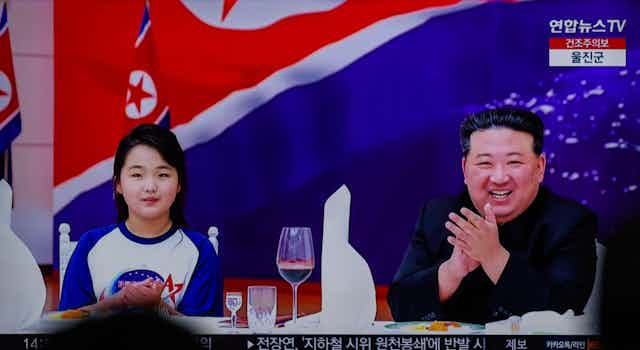This year, unusually, North Korea allowed more than one candidate on the ballot for the recent local elections. Under new laws introduced in August this year, voters are now asked to choose between two candidates for North Korea’s local and regional assemblies. Then in a second vote, they either approve or disapprove of the winning candidate by placing their ballot papers in either a green box (approve) or a red box (disapprove).
A spokesperson from South Korea’s ministry of unification dismissed the changes as an attempt to give an appearance of democracy at a time when people in North Korea are facing severe economic hardships. It was also an attempt to enhance the country’s image on the international stage.
The fact is that not only are all candidates selected by the state but also the ballot boxes are closely monitored. So there is a large amount of scepticism about the extent of this “reform”.
The results were still predictable: according to the North Korea’s state news agency, KCNA, about 99% of people still voted for the approved candidates. And it appears that any democratic changes won’t alter North Korea’s dynastic power structure. Except that now it seems that Kim Jong-un is grooming a daughter, rather than a son, to be the next “Dear Leader”.
Little is known about Kim’s children. He is reported to have three: two girls and a boy. US basketball star Denis Rodman – who has been close to the North Korean leadership – reported in 2013 that Kim had an infant daughter, Ju-ae, which would make her 11 or 12 now.
She first appeared in North Korea’s state newspaper, Rodong Sinmun, on 19 November 2022, accompanying Kim as he witnessed the launch of a North Korean intercontinental ballistic missile. She then popped up again at North Korea’s Korean Central Television on 1 January this year. This time, she was inspecting nuclear warheads with her father. The following month, she was with Kim at a ceremony to mark the 75th anniversary of the founding of North Korea’s army.
Traditionally, North Korea’s leader wields power by control of the “trinity” of the military, the party and the people. So analysts will be watching to see if Ju-ae continues on this path.
Kim Jong-il’s ascent to power
The first leader in the Kim dynasty, Kim Il-sung, began to groom his son Kim Jong-il for power in the early 1970s when he was in his early 30s. He was named number two in the Korean Workers’ Party (KWP) in the party in September 1973 and elected to the political bureau of the party’s central committee in February 1974.
Kim Jong-il spent the next few years consolidating his political power and in October 1980, at the 6th Congress of the KWP, he was officially designated as successor to his father.
In September 1991 Kim Jong-il was named as supreme commander of the Korean People’s Army, while in 1992, Kim Il-sung publicly stated that his son was in charge of all internal affairs in the Democratic People’s Republic. Kim Jong-il made his first public speech in 1992. So by 1994, when Kim Il-sung died at the age of 82, his son had been deliberately and carefully groomed with all three arms of the trinity: the army, the party and the people.
Kim Jong-un: ‘great successor’
But the succession was not as smooth for Kim Jong-un as his father’s death in 2011 was sudden and unexpected.

Kim Jong-il began to groom his third son for the leadership in 2002, passing over two older sons. Eldest son Kim Jong-nam was disqualified because his mother was originally from South Korea and some of her family members had defected. For a time it seemed as if second son Kim Jong-chol would be named as the successor, but it is thought he was passed over because of a lack of ambition.
There were concerns about Kim Jong-un. Under North Korea’s rigid caste system, the songbun, Ko Yong-hui, mother of Kim Jong-un was from the lowest tier, being born in Japan of Korean stock. It has been reported that Kim Jong-il tried to remove official records to obscure her inappropriate origins.
Having been educated at an international school in Switzerland, Kim Jong-un attended the National War College in Pyongyang from 2002 to 2007. Reports of Kim Jong-un being groomed for the leadership began to emerge in 2008 and in 2010 he was appointed as the equivalent of a four-star general and attended the KWP’s 65th-anniversary celebration with his father.
When Kim Jong-il died in December 2011, his son’s training had not been completed and his position was vulnerable. He moved quickly to take control of both military and party. Over the next few years, Kim Jong-un consolidated his position with a series of purges, including that of his uncle Jang Song-thaek, who had acted as regent after Kim Jong-il’s death and was reported to have been executed by firing squad as Kimg Jong-un “removed the scum” from the KWP.
Kim Ju-ae’s path to leadership
Because of this, Kim Jong-un is likely to be aware of the need to allow time to prepare a successor: hence the appearance of Kim Ju-ae, despite being so young. Last month, Kim Jong-un referred to his daughter as “Morning Star General”, prompting serious speculation among Korea-watchers. Kim Il-sung was apparently referred to as “Morning Star” in the 1920s and 1930s when he was emerging as an independence fighter when Korea was occupied by Japan.
But the big question is how easy it will be for Kim Jung-un to legitimise his daughter’s succession in a heavily patriarchal society. This will involve changing both society and state, while the idea of the Kim dynasty remains intact.
So it’s possible that this recent electoral reform is a signal that Kim Jong-un is preparing this deeply conservative country for an even bigger change ahead.

